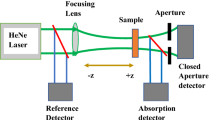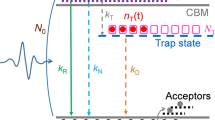Abstract
The two-dimensional position dependent probe absorption spectrum of a driven four-level Λ-type atomic system with twofold lower-levels interacting with two orthogonal standing wave laser fields and one microwave field is investigated. It is found that due to the position dependent nature of atom–field interaction, the spatial distribution of the atom can be controlled by scanning the resulting absorption spectra of the weak probe field. The effect of different controlling parameters of the system such as detunings, the intensity of standing wave fields as well as the relative phase of applied fields on the position measurement uncertainty of the atom is then discussed. We show that by properly adjusting the system parameters, different spatial structures of localization as ‘∞’-like, spot-like, deltoid-like and elliptic like patterns can be designed, so that high-precision and high-resolution atom localization can be engineered.








Similar content being viewed by others
References
Abfalterer, R., Keller, C., Bernet, S., Oberthaler, M.K., Schmiedmayer, J., Zeilinger, A.: Nanometer definition of atomic beams with masks of light. Phys. Rev. A 56, R4365–R4368 (1997)
Bai, Y., Yang, W., Yu, X.: Controllable Kerr nonlinearity with vanishing absorption in a four-level inverted-Y atomic system. Opt. Commun. 283, 5062–5066 (2010)
Cheng, D., Liu, C., Gong, S.: Optical bistability and multistability via the effect of spontaneously generated coherence in a three-level ladder-type atomic system. Phys. Lett. A 332, 244–249 (2004)
Ding, C., Li, J., Yang, X.: Radio-frequency control of spontaneous emission from a coherently driven multilevel atom. Opt. Commun. 283, 2705–2715 (2010)
Ding, C., Li, J., Yang, X., Zhan, Z., Liu, J.-B.: Two-dimensional atom localization via a coherence-controlled absorption spectrum in an N-tripod-type five-level atomic system. J. Phys. B: At. Mol. Opt. Phys. 44, 145501 (2011a)
Ding, C., Li, J., Yang, X., Zhang, D., Xiong, H.: Proposal for efficient two-dimensional atom localization using probe absorption in a microwave-driven four-level atomic system. Phys. Rev. A 84(4), 043840 (2011b)
Ding, C.L., Li, J., Zhan, Z., Yang, X.: Two-dimensional atom localization via spontaneous emission in a coherently driven five-level M-type atomic system. Phys. Rev. A 83, 063834 (2011c)
Hamedi, H.R.: Transient and steady-state properties of asymmetric semiconductor quantum wells at Telecom wavelength bands. JETP Lett. 100(1), 47–58 (2014a)
Hamedi, H.R.: Ultra-slow propagation of light located in ultra-narrow transparency windows through four quantum dot molecules. Laser Phys. Lett. 11, 085201 (2014b)
Hamedi, H.R.: Electron localization in an asymmetric double quantum well nanostructure (II): improvement via Fano-type interference. Phys. B 450, 128–135 (2014c)
Hamedi, H.R.: Transient absorption and lasing without inversion in an artificial molecule via Josephson coupling energy. Laser Phys. Lett. 12, 035201 (2015)
Hamedi, H.R., Juzeliūnas, G., Raheli, A., Sahrai, M.: High refractive index and lasing without inversion in an open four-level atomic system. Opt. Commun. 311, 261–265 (2013a)
Hamedi, H.R., Asadpour, S.H., Sahrai, M.: Giant Kerr nonlinearity in a four-level atomic medium. Optik 124, 366–370 (2013b)
Hamedi, H.R., Radmehr, A., Sahrai, M.: Manipulation of Goos–Hänchen shifts in the atomic configuration of mercury via interacting dark-state resonances. Phys. Rev. A 90, 053836 (2014)
Han, D., Zeng, Y., Bai, Y.: Optical knobs from slow- to fast-light with gain in low-dimensional semiconductor heterostructures. Opt. Commun. 284, 4541–4545 (2011)
Harris, S.E.: Lasers without inversion: interference of lifetime-broadened resonances. Phys. Rev. Lett. 62, 1033–1036 (1989)
Johnson, K.S., Thywissen, J.H., Dekker, W.H., Berggren, K.K., Chu, A.P., Younkin, R., Prentiss, M.: Localization of metastable atom beams with optical standing waves: nanolithography at the Heisenberg limit. Science 280, 1583–1586 (1998)
Kapale, K.T., Zubairy, M.S.: Subwavelength atom localization via amplitude and phase control of the absorption spectrum. II. Phys. Rev. A 73, 023813 (2006)
Li, J.-H.: Controllable optical bistability in a four-subband semiconductor quantum well system. Phys. Rev. B 75, 155329 (2007a)
Li, J.H.: Control of spontaneous emission spectra via an external coherent magnetic field in a cycle-configuration atomic medium. Eur. Phys. J. D 42, 467–473 (2007b)
Li, J.-H., Lü, X.-Y., Luo, J.-M., Huang, Q.-J.: Optical bistability and multistability via atomic coherence in an N-type atomic medium. Phys. Rev. A 74, 035801 (2006)
Li, J., Hao, X., Liu, J., Yang, X.: Optical bistability in a triple semiconductor quantum well structure with tunnelling-induced interference. Phys. Lett. A 372, 716–720 (2008)
Li, J., Yu, R., Liu, M., Ding, C., Yang, Xiaoxue: Dipole-induced grating in a waveguide-coupled photonic crystal microcavity embedding a driven three-level emitter. Phys. B 406, 3963–3968 (2011a)
Li, J., Yu, R., Liu, M., Ding, C., Yang, X.: Efficient two-dimensional atom localization via phase-sensitive absorption spectrum in a radio-frequency-driven four-level atomic system. Phys. Lett. A 375, 3978–3985 (2011b)
Metcalf, H., Van der Straten, P.: Cooling and trapping of neutral atoms. Phys. Rep. 244, 203–286 (1994)
Ou, B.-Q., Liang, L.-M., Li, C.-Z.: Quantum coherence effects in a four-level diamond-shape atomic system. Opt. Commun. 282, 2870–2877 (2009)
Sahrai, M., Tajalli, H., Kapale, K.T., Zubairy, M.S.: Subwavelength atom localization via amplitude and phase control of the absorption spectrum. Phys. Rev. A 72, 013820 (2005)
Sahrai, M., Etemadpour, R., Mahmoudi, M.: Dispersive and absorptive properties of a Λ-type atomic system with two fold lower-levels. Eur. Phys. J. D 59, 463–471 (2010)
Steck D.A.: Rubidium 87 D line data. http://steck.us/alkalidata
Storey, P., Collett, M., Walls, D.: Atomic-position resolution by quadrature-field measurement. Phys. Rev. A 47, 405–418 (1993)
Vanier, J., Godone, A., Levi, F.: Coherent population trapping in cesium: dark lines and coherent microwave emission. Phys. Rev. A 58, 2345–2358 (1998)
Wang, Z., Yu, B.: Optical bistability and multistability via dual electromagnetically induced transparency windows. J. Lumin. 132, 2452–2455 (2012)
Wang, Z., Yu, B.: High-precision two-dimensional atom localization via quantum interference in a tripod-type system. Laser Phys. Lett. 11, 035201 (2014)
Wang, Z., Chen, A.-X., Bai, Y., Yang, W.-X., Lee, R.-K.: Coherent control of optical bistability in an open-type three-level atomic system. J. Opt. Soc. Am. B 29, 2891–2896 (2012a)
Wang, C.L., Kang, Z.H., Tian, S.C., Wu, J.H.: Control of spontaneous emission from a micro-wave driven atomic system. Opt. Express 20, 3509–3518 (2012b)
Wang, Z., Yu, B., Zhen, S., Wu, X.: Large refractive index without absorption via quantum interference in a semiconductor quantum well. J. Lumin. 134, 272–276 (2013a)
Wang, Z., Yu, B., Xu, F., Zhen, S.: Coherent control of two-dimensional probe absorption in semiconductor quantum wells. Appl. Phys. A 112, 443–449 (2013b)
Wu, Y.: Two-color ultraslow optical solitons via four-wave mixing in cold-atom media. Phys. Rev. A 71, 053820 (2005)
Wu, Y., Cˆot´e, R.: Bistability and quantum fluctuations in coherent photoassociation of a Bose–Einstein condensate. Phys. Rev. A 65, 053603-1–053603-5 (2002)
Wu, Y., Yang, X.: Highly efficient four-wave mixing in double-Λ system in ultraslow propagation regime. Phys. Rev. A 70, 053818 (2004)
Wu, Y., Yang, X.: Electromagnetically induced transparency in V-, Λ-, and cascade-type schemes beyond steady-state analysis. Phys. Rev. A 71, 053806 (2005)
Wu, Y., Yang, X.: Giant Kerr nonlinearities and solitons in a crystal of molecular magnets. Appl. Phys. Lett. 91, 094104 (2007a)
Wu, Y., Yang, X.: Strong-Coupling Theory of Periodically Driven Two-Level Systems. Phys. Rev. Lett. 98, 013601 (2007b)
Wu, Y., Chu, M.C., Leung, P.T.: Dynamics of the quantized radiation field in a cavity vibrating at the fundamental frequency. Phys. Rev. A 59, 3032 (1999)
Wu, Y., Payne, M.G., Hagley, E.W., Deng, L.: Efficient multiwave mixing in the ultraslow propagation regime and the role of multiphoton quantum destructive interference. Opt. Lett. 29, 2294–2296 (2004)
Xiao, Z.-H., Kim, K.: Optical bistability using quantum coherence in a microwave-driven four-level atomic system. Opt. Commun. 283, 2178–2181 (2010)
Xu, J., Li, Q., Yan, W., Chen, X., Hu, X.: Sub-half-wavelength localization of a two-level atom via trichromatic phase manipulation. Phys. Lett. A 372, 6032–6036 (2008)
Yang, W.-X., Hou, J.-M., Lee, R.-K.: Ultraslow bright and dark solitons in semiconductor quantum wells. Phys. Rev. A 77, 033838 (2008)
Yang, W.-X., Zha, T.-T., Lee, R.-K.: Giant Kerr nonlinearities and slow optical solitons in coupled double quantum-well nanostructure. Phys. Lett. A 374, 355–359 (2009)
Zhang, D., Li, J., Ding, C., Yang, X.: Control of optical bistability via an elliptically polarized light in a four-level tripod atomic system. Phys. Scr. 85, 035401 (2012)
Zhang, D., Yu, R., Li, J., Ding, C., Yang, X.: Laser-polarization-dependent and magnetically controlled optical bistability in diamond nitrogen-vacancy centers. Phys. Lett. A 377, 2621–2627 (2013)
Zhang, D., Yu, R., Li, J., Hao, X., Yang, X.: Efficient two-dimensional atom localization via phase-sensitive absorption and gain spectra in a cycle-configuration four-level atomic system. Opt. Commun. 321, 138–144 (2014)
Acknowledgments
H. R. Hamedi gratefully acknowledges the support of Lithuanian Research Council (No. VP1-3.1-ŠMM-01-V-03-001).
Author information
Authors and Affiliations
Corresponding author
Appendix
Appendix
Taking into account only the strong driven fields, the effective Hamiltonian in an interaction picture can be expressed as (Sahrai et al. 2005; Kapale and Zubairy 2006)
which is in the basis {\(\left| c \right\rangle\), \(\left| d \right\rangle\), \(\left| b \right\rangle\)}. The above equation leads to the secular equation
with λ being the eigenenergies of the Hamiltonian. The positions of dressed sublevels \(\left| {\lambda}_{1} \right\rangle\), \(\left| {\lambda}_{2} \right\rangle\) and \(\left| {\lambda}_{3} \right\rangle\) generated by the driven fields can be obtained by the dressed state eigenvalues λ. Probing \(\left| a \right\rangle\) ↔ \(\left| {\lambda}_{i} \right\rangle\)(i = 1, 2, 3) by the weak probe field, the resonances will occur at the points where the probe frequency matches the energy-level difference between the levels \(\left| a \right\rangle\) and \(\left| {\lambda}_{i} \right\rangle\). If the probe detuning Δ p is chosen to be in resonance with one of the dressed states then it experiences absorption maxima.
Equation 14 shows that the eigenvalues of the three dressed sublevels are dependent on the relative phase ϕ through term 2Ω c Ω d Ω m cos ϕ. Here, for simplicity, we take Δ c = Δ m = 0 and Ω c = Ω d = Ω m = Ω and then, Eq. 14 reads
As a result, for example, when ϕ = 2 mπ, the eigenvalues become λ 1 = λ 2 = Ω and λ 3 = −2Ω, while for ϕ = (2 m + 1)π, they are λ 1 = 2Ω and λ 2 = λ 3 = −Ω. Moreover, for \( \phi = \left( {m + \frac{1}{2}} \right)\pi \), the eigenvalues are \( \lambda_{1} = \sqrt 3 \Omega ,\lambda_{2} = 0,\lambda_{3} = - \sqrt 3 \Omega \) (m integer). Consequently, different contribution of three bare-state levels to the dressed states can lead to different localization patterns and precision of an atom.
Rights and permissions
About this article
Cite this article
Raheli, A., Sahrai, M. & Hamedi, H.R. Atom position measurement in a four-level Lambda-shaped scheme with twofold lower-levels. Opt Quant Electron 47, 3221–3236 (2015). https://doi.org/10.1007/s11082-015-0202-6
Received:
Accepted:
Published:
Issue Date:
DOI: https://doi.org/10.1007/s11082-015-0202-6




